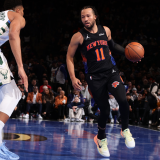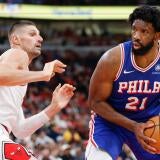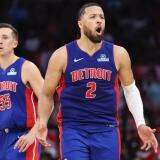LeBron James is playing a new brand of elite defense as the Lakers continue to shut down the entire NBA
With renewed effort and mastery of his new scheme, LeBron is a different kind of star defender this season
LeBron James used to be an apex predator on defense. The Miami Heat built one of the most aggressive schemes in NBA history around his athleticism, relentlessly blitzing pick-and-rolls knowing that he, Dwyane Wade and Chris Bosh could suffocate ball-handlers without sacrificing the overall integrity of the defense. He made that intensity his defensive identity. Throwing a pass into his territory at that point practically amounted to punting away a possession.
At that point, there was practically nothing he couldn't do defensively. He once held 2011 MVP Derrick Rose, who is five inches shorter than him, to 1 of 15 shooting across the final two games of a playoff series. This version of James led three top-five defenses in four seasons, earned first team All-Defense honors five years in a row, and was runner-up to Marc Gasol for the 2012-13 Defensive Player of the Year award.
That version of James has not existed for five years. For most of the last two, he has been outright bad. The 2017-18 Cavaliers were 8.3 points per 100 possessions better defensively when he sat. Last season's Lakers tied for the sixth-best defense in basketball during the brief stretch between his Christmas Day injury and his late-January return, but fell to 20th from the moment he came back through the end of the season. Things got so bad that a frustrated Kyle Kuzma pushed James into an opposing shooter to play some defense.
The charitable explanation was that James, by then in his mid-30s, needed to preserve his energy for offense. The uglier one was that he was lazy. His help defense last season mostly ended up helping the other team.
His closeouts were just as bad, though he would occasionally make a show of overcommitting. James hears his critics, after all, so when he wasn't ignoring shooters, he was lunging desperately at either lost causes or drivers willing to take advantage of lanes he provided.
Reconciling these two versions of LeBron is nearly impossible. It was only three years ago that he made perhaps the greatest defensive play in NBA history in chasing down Andre Iguodala for a championship-saving block. The pattern persisted. Occasionally, James would remind the world of what he used to be, confounding fans and critics alike into wondering why the newer model so rarely lived up to the original.
And so, it seems fitting that James' defensive revival this season has come by shunning that feast or famine model. At 34, LeBron looks almost nothing like the wrecking ball he once was. He isn't asked to defend MVPs anymore. He doesn't sprint the length of the court to swat away the inattentive layups of lesser players. LeBron 3.0 is a compromise, the result of an aging player accepting and operating within his limitations. James once was a defensive system unto himself. Now, he is working within someone else's, choosing to play consistently good defense instead of the formerly frequently but lately only occasionally stunning variety we've grown used to.
Nowhere is this more evident than in his closeouts. James' new approach to shooters is rooted in the way Frank Vogel wants the Lakers to defend.
He closes the gap quickly and extends a hand, but James almost never leaves his feet to contest jump shots anymore. That conservative tactic is surprising in light of the risks James took at his peak, but it serves multiple purposes within the context of this scheme. First and foremost, it preserves his body. It also protects him against pump fakes and drives without surrendering clean looks as well. The advantage of playing James at small forward is that he has a size advantage over most of the players he defends. But mostly, it pushes offenses into the kinds of shots that the Lakers want to give up. The strategy is working.
The Lakers allow only 14.3 wide-open 3-pointers per game. That is the eighth-best figure in the NBA. Last season, they allowed 19.6. That was the second-most in all of basketball. In turning uncontested jumpers into guarded ones, Vogel has managed to significantly improve the overall shot profile his defense is allowing. Only 35.9 percent of shots taken by Lakers' opponents have come from behind the arc. Last season's figure was higher at 36.6 percent, and the league is taking more 3-pointers as a whole. The gap between those two numbers is significant. The NBA is taking more 3s. The Lakers are giving up less.
That leaves opponents with almost nowhere to go. After all, they can't exactly attack Anthony Davis and Dwight Howard at the basket. Opponents are shooting 62.5 percent within three feet of the rim against the Lakers, the ninth-best total in basketball, but one that's likely to improve as other teams regress. Last season, that figure would have been ranked third. That is where the Lakers are ranked on shots between three-to-10 feet of the basket, where they allow opponents to shoot only 33.1 percent. Pick almost any area on the court and the Lakers play elite defense there. There is one major exception, and it was apparent in James' most-difficult defensive assignment of the season so far: DeMar DeRozan.
The Lakers practically beg teams to shoot mid-range jumpers. They have allowed opponents to shoot 45.5 percent on 2-pointers longer than 16 feet, but in doing so, they are goading opponents into the eighth-most shots from that area in the NBA.
LeBron executed that vision flawlessly against DeRozan. He fought through screens and chased him around the court as any good defender would, but when the time came for DeRozan to take his mid-range jumpers, James provided minimal resistance. The general inefficiency of such shots won out. DeRozan went 5 of 15 from the field, and just as importantly, took only five free throws.
DeRozan is the only ball-dominant star that James has spent a significant amount of time defending this season, and with good reason. Forcing DeRozan into bad jumpers is a relatively low-impact assignment by superstar standards, far less taxing than, say, battling James Harden for an entire night. For the most part, James has been asked to start possessions on wing shooters.
That is giving him chances to end possessions in higher-leverage spots. The Lakers are not a switch-happy team. Their ideal response to a ball screen is to drop their big man and protect the rim, but off of the ball, Vogel has taken advantage of James' versatility. If he starts possessions on a shooter, there is little harm in letting him switch because he can guard anyone, and almost anyone on this roster can stick with his original assignment. This gives the Lakers tremendous flexibility against almost any offense. That flexibility was put on display against a Chicago Bulls front-court that can shoot.
This is where shades of the old LeBron are most often felt. James is one of history's few true five-position defenders, and Vogel would be foolish not to take advantage of that when the opportunity presents itself. The key is that James doesn't hunt for those opportunities anymore. He lets them find him. Just compare some of his steals during his peak with the Heat to the ones he's coming up with as a Laker this season.
LeBron used to force turnovers in the most literal sense of the word. He forced teams into making reckless decisions with the ball and then used his freakish athleticism to take it away. The first play of that compilation is a perfect example. James sees the second pass Charlotte could make before the first one even arrives, so he dares Josh McRoberts to make it by leaving his man open knowing that there is no way that McRoberts can sneak the ball past him.
James doesn't need to play that way anymore. Avery Bradley and Alex Caruso make aggressive plays at the point of attack. Davis and Howard repel anyone who tries to approach the rim. All he needs to do is put himself in the right place at the right time, and his extrasensory perception takes care of the rest. A remarkable number of his steals this season have come either in a relatively stationary position or in his normal course of movement. He is just so remarkably aware of everything that happens on the court that he can feast on the sort of common mistakes that many defenders miss.
The same was true last season, and while improved strategy and personnel certainly matter, the simple difference has been effort. That effort is rubbing off on his teammates. "It's contagious," Vogel said, according to Bill Oram of The Athletic, "and his commitment on that end of the floor has been a great surprise for us in terms of just how proficient he's been. He's leading the charge with care factor on that end of the floor."
"When he's working that hard and caring that much about getting stops, it carries over to everybody else, and you see it on the floor."
The contrast to last season's doom and gloom is stark. A year ago, James had to literally be pushed into playing defense. Now, with a 6-1 record and the NBA's top-ranked defense, he is the one pushing his teammates to dominate on that end of the floor.


















